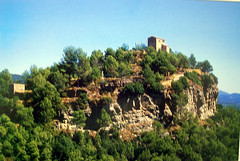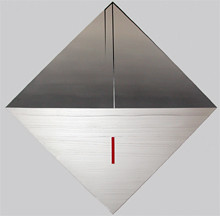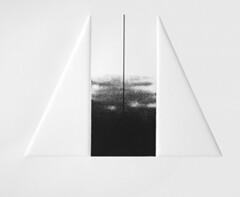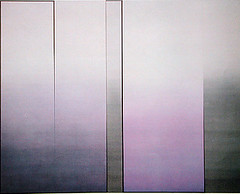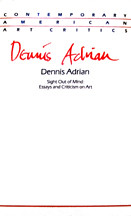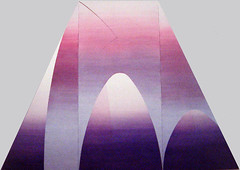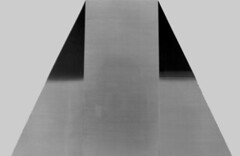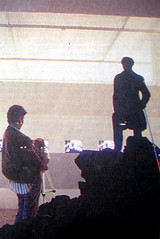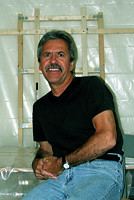The New Art Examiner/ March 1979
The Axiomatic Image
The Works of Dan Ramirez
The New Art Examiner has requested a number of critics to write an extended piece on the work of a single artist of their choice. This essay by Buzz Spector on Dan Ramirez is third in the series.
by Buzz Spector
I first met Dan Ramirez in September 1976, when we were both graduate students in art at the University of Chicago. He stood out among his classmates, being both older and more definitely committed to a particular mode of' art-making. Despite the increasing demands made upon his schedule by the momentum of his already established exhibiting career, he freely gave of his time to talk about the issues raised through his own work and that of others in the graduate program. We worked together for a year, until Dan finished, picking up his M.F.A. and moving into a loft west of the Ontario-Hubbard gallery nexus. We kept in contact, though, and shortly after I graduated from Midway Studios. I rented space in that same loft, joining Dan and four other artists. From this vantage point, across the hall, I have watched his continued growth-both as a maker of things and as a thinker about them. In his passionate commitment to quality in his own art, and his uncompromising yet compassionate viewpoint towards the works and ideas of his fellow artists, he remains my friend and my best model for the sort of intellectual and emotional integrity which should attend the practice of art.1
6.31
Skepticism is not irrefutable, but obviously nonsensical, when it tries to raise doubts where no questions can be asked.
For doubt can exist only where a question exists, a question only where an answer exists, and an answer only where something can be said.
Ludwig Wittgenstein, from the Tractatus
When the Renaissance Society at the University of Chicago opens its survey of the works of Dan Ramirez this month, it will mark the first extensive institutional recognition of the paintings and drawings of this intense and energetic artist from Chicago's Southside. Since his first solo exhibit, at Don Roth's Blackhawk restaurant in 1974, Ramirez's art has been seen with increasing frequency, and with increasing critical acclaim. Through four subsequent one-artist shows, and appearances in a number of museum and institutional group exhibitions, Ramirez has moved to a central position within the Chicago art community. Consistent through all his recent exposure has been enthusiastic critical support. In fact, one rather unusual feature of Ramirez's body of work has been its ability to draw support and appreciation from critics and reviewers holding extremely divergent, if not contradictory, attitudes about what determines quality in works of art. It is my belief that this critical response has been as much to the philosophical stance which Ramirez takes toward his works-and his responsibilities as an artist- as it has been to the technical and conceptual merits of the work itself.
For the past seven years Dan Ramirez has been making an art of extraordinary visual clarity and restraint-an art whose attention to rigorous structural logic is exacting in the extreme-but an art whose significance in large part rests with the absolute faith of its maker in its evocation of the sublime. A belief in the possibility of that faith becoming manifest through the artist's imposition of meaning upon his works-ascribing a spiritual essence to the elements of his paintings and drawings by means of an argument drawn from the popositional method of Wittgenstein.
Through his works and through the argument which accompanies them this 37 year-old graduate of the University of Illinois' Circle Campus and the University of Chicago means to communicate an ideal of self to the world. This is an ideological stance, which has been pursued by many artists of the post-Abstract Expressionist era, but few have taken it with both the energy and activism of Ramirez. It is a position which has driven him to produce simultaneously perhaps the most formally cohesive and critically respected body of art works among Chicago's emerging generation of abstract artists, and a series of statements, both written and verbal, on the relationship of metaphor to language and art which he is presenting as part of his application to candidacy in the Ph.D. programs in Ideas and Methods and Social Thought at the University of Chicago.
The crux of the matter for Ramirez is his belief that neither his work nor his reasoning for it are sufficient, in themselves, to communicate his faith to the world, but that through the interweaving of his methods of philosophical investigation and artistic execution, the message may be expressed. In summing up the attitude behind his methodology he says: "It is a personal response to a very frustrating situation: the inability to articulate and justify the metaphorical validity of the works [of art] in question." l
Art excludes the unnecessary, Frank Stella has found it necessary to paint stripes. There is nothing else in his painting. Frank Stella is not interested in expression or sensitivity. He is interested in the necessities o£ painting. Symbols are counters passed among people. Frank Stella's painting is not symbolic. His stripes are paths of brush on the canvas. These paths lead only to painting.
Carl Andre, "Preface to Stripe Painting" Sixteen Americans, Museum of Modern Art, New York, 1959.
Andre's text, like the painting it describes, has become part of the critical context of modernism. It locates the absolute validity of painting (and by implication the practice of any artistic discipline) in the reduction of its elements to that which is "necessary" to the practice itself. In Stella's irregularly shaped canvases of the early 1960's the pictorial field was a function of the pattern that governed it. Andre, along with Robert Morris, Donald Judd, and Sol Lewitt, extended this notion of the interrelatedness of form and subject through
Minimalist Art-generating the criteria that a work of art be geometric in shape, basic in structure, monochromatic, its own object, bound by its own frame.2
The idea posited in the Minimalist stance is that there is an absolute order in the world, an order whose manifestation has been the concern of many human societies in the past-hence the Minimalists' ongoing interest in Middle Eastern and Asian art and history-and whose promulgation in modern technological society was best engendered through the materials of that society. For the Minimalists, the perception of that order via the Minimalist situation was equivalent to the sense of calm and order provoked by the dolmens at Stonehenge, or a Japanese formal garden. Of such gardens Andre has written, "These are places charged with a great calm, a very strong calm and a feeling of, if one cannot really contain the universe, perhaps, in one's mind, then in these gardens one has the very secure feeling that one is contained in the universe."3
Aside from its emphasis on industrial materials and fabrication, there is in the Minimalist position a strong conception of "place" as an active element in the perception of order. It is an idea of place whose ontological resonance comes from its attachment to the notion of where something is, or the creation of a place by a work. That is the awareness of one's position in relation to the (Minimalist) object, and, hopefully, perception of the object's orderly presence, makes possible an awareness of one's position in relation to the universe-the provocation of that awe serving as the works' function. Operating behind this line of reasoning is a contextually oriented attitude towards the installation of works, which has lead the Minimalists to graft-by means of argument outside the realm of direct sensory experience-the situation of the formal garden onto the situation of their work in a gallery, in effect asking the viewer to deal with the gallery space as a sort of shrine.
For Dan Ramirez the problem with this position is its essentially passive association of meaning with perception and material as structure rather than with practice and material as metaphor. The structure dictated by the materials of Minimalism is meaningless to Ramirez in that it refers only to itself-unsupported by the argument which seeks to analogise those materials to the space in which they are displayed. By subverting the associative (and thus, metaphorical) potential of their materials, the Minimalism locate the responsibilities for their works' content outside themselves, in the contextual value which accrues to the object through its placing in a particular site.
In his proposal addressed to the University of Chicago's Committees on Ideas and Methods and Social Thought, Ramirez writes, "When an artist presents his work, the work is not the interpreter of the information; the artist is, in conjunction with the [viewer's] response. The work is no more than an extension of the human being who made it. The work can never be absolute unto itself."
Ramirez's feeling is that the reaction by a viewer to a Minimalist work in situ is a situation essentially without value. The viewer's response is behavior in a real enough sense, but it is not a response to the presentation of self
by the artist. And for Ramirez the presentation of self is absolutely central to the valid creative act. Ramirez equates the practice of his painting with the practice of faith. He bases his own apprehension of the success or failure of his works upon his use of the medium-whether paint or graphite--as the metaphor of revelation, a "seeing of the light," He says, "Paint is metaphor. It's about the idea of light. Your medium is metaphor. For an artist to paint and deny this metaphor is absurd."
Between the idea/And the reality
Between the motion/And the act
Falls the Shadow
T. S. Eliot, from The Hollow Men
In the shimmering, aurora-like surfaces of his painting, by the silvery sheen of his more recent graphite panels
Ramirez presents a glorious actualization of light. The references to atmosphere-the sun-flushed dawn-are vivid
and compelling, especially in the paintings, but even the interstellar blackness of his graphite drawing TL.P S.6-5.641/and she had black hair/ALSO (recently purchased by the Art Institute) yields an austere metallic gleam.
One particularly striking visual meditation is Ramirez's TL.-P 6.42.1, the last painting he completed before leaving Midway Studios in March, 1977. Its two 5 x 8-foot rectangular canvas panels are bolted together by their long axes. Each panel is in turn divided into what can only he described as areas of space, upon which Ramirez has patiently worked a multitude of thin washes of violet and lavender acrylic pigment, building up a varying sequence of tonal gradations. The washes gradually gain in intensity, resulting in a rendered light with palpably romantic overtones.
Like the
German Romantic painters Caspar David Friedrich and Philip Otto Runs-whom he much admires-Ramirez creates an atmosphere here charged with mystery, evoking a premonitory awareness of spaces within which something is about to happen. These spaces are energized and given emanence by the painted lines within which they are bound. Darting, thrusting, here bold, there ethereal, Ramirez's panels are contained by taut strands of line.
Straight, suggestively geometric, and insistently demarcative, Ramirez's lines are dazzling in their incisiveness. If the artist's rectangular or trapezoidal fields of space glow with sublime silence, then the lines which course through them sound a devotional note. Ramirez is a genius at applying a line whose breadth is just right for its context, tensely balanced between the ether of his field and the weight of his format. The lines inflect and add incidence to Ramirez's painted surfaces, generating sufficient compositional variation to prevent the viewer from focusing too strongly on the objectness of their support.
While the paintings bring forth an atmospheric emanation, emphasizing the transparency of their medium, Ramirez's graphite drawings call attention to their surfaces, almost celebrating their objectness and material qualities. These are challenging works, less visually accessible than the artist's paintings. For one thing, the chromatic analogy between Ramirez's pigment and sky colors is not present. The reference here is to reflected light via the metallic sheen of his surfaces. Also, the evidence of Ramirez's working method is more obviously present. Instead of a nacreous diffusion of acrylic washes, the strokes of Ramirez's Lumograph pencils are stacked and contiguous-each ruled stroke clearly defined if you examine his drawings' surfaces closely enough. The obsessive deliberateness of his stacks of horizontally ruled strokes builds up a materially weighty, yet visually flickering surface, activated by the lighting of their installation.
In some of these works, notably in TL-P 5.6-5.641…, the graphite is shaded into areas of matte black latex paint. The effect is startling, as the dense metal of the pencil suddenly evanesces into a black void. In its recent display at the Art lnstitute's Works on Paper show (where it was awarded the Frank G. Logan Prize), the 'gleam of its eight-foot tall rectangular center panel was inflected by the black latex vertices of the right triangular panels which adjoined it. The apparent nullity of the vertices gave way to graphite sheen just above the midpoint of the trapezoidal composition (at eye level), drawing attention to the edges along which the three panels were joined. The effect was to make those edges into virtual lines, slicing through the field and dematerializing the surface, much the way a jet contrail makes evident the depth of a sky.
TL-P 5.6.5.641...is a disturbing work, whose aggressive metal presence seems constantly on the verge of obscuring its subtler reflective qualities. Yet that extreme evidence of drawn line-becoming in its repetition a sort of splendid metal foil-is a dramatic bringing-together of metaphysical light and will. Here, more than anywhere else in Ramirez's works, does one sense a gift of light as an expression of execution, of the artist's will.
In the tripartite tension Ramirez engenders between line, field, and shape, the viewer encounters works of reductive, elemental simplicity and grace. But to deal with the wholeness of Ramirez's works is to encounter a logical as well as an experiential beauty. For each work is but the final step in a devotional research of visual logic by the artist. The process begins at a minuscule scale in the sketches by which Ramirez investigates the possible combinations of elements which could make up a work to follow.
In a recent conversation he said of them, "The sketches are visual metaphors for my searching. The little drawings are closer to writing than to my finished paintings. They are the first record and documentation of my ideas."
Ramirez has spoken of a set of four criteria which he uses in refining the structural investigations of his sketches, criteria which he posits are necessary for expression and communication to occur, within the context of a given medium: 1) There must be a grouping of elements of a similar nature; 2) There must be potential for a logical (axiomatic) extension of the elements 3) There must be a context for the conclusion; and 4) The conclusion must be possible within the structure given.
Without going too deeply into the arena of symbolic logic, it can be said that these criteria are as applicable to statements of language as they are to objects of art. Ramirez goes on to say that language, both spoken (aural) and written (visual) is metaphorical by its very nature, and further, that all metaphors, whatever their medium of presentation, function equivalently-as axioms of "the infinite." This is a usage of "infinite" charged with a poetic sense of the sublime, yet it is coupled with "axiom," the mathematical reference to propositions regarded as
self-evident truths. There is, however, a second mile of axiom which brings us closer to the real sense of Ramirez's assertion: that it is a "maxim widely accepted on its intrinsic merit.' As acceptance thus becomes a form of belief-of faith based on meritorious qualities-so Ramirez's propositions become a sort of catechism requisite to his vision of the appropriate practice of art.2.182
Every picture is at the same time a logical one.
Ludwig Wittgenstein, from the Tractatus
At one point in the Tractatus Wittengenstein examines the phenomenon of the "
Neckercube," that odd illusion of isometric projection in which a cube reverses its spatial relationship to the paper it is printed upon depending on which set of axes the viewer focuses on first. For Wittsenstein, the two possible points of view became two "facts" about the drawing. But to render such a cube so that those two points of view are entwined is to make it-apparently-an impossible state of affairs. The drawing is tautological in that the knowledge it imparts is but a rephrasing of its subject. Yet, it is a false statement since the plane (A) cannot be in two places at the same time.
For Ramirez, however, the contradiction is not complete, and in the following statement, taken from his proposal, he presents a response extraordinarily reflective of his belief in the ideal form of communication:
How does one determine what is actually here? One is tempted to say that nothing is here, it is senseless tautology, needless repetition, a pulsating back and forth. However that's not true! We have learned! It has communicated! We have learned that simultaneity is only possible in the form of a metaphor. It is not possible
in actuality. After all, we can believe the cube when looked at from the point of view of ...metaphor- a thinking process! For then it is LIKE THE IDEA , of simultaneity. But we cannot believe the cube if we believe our eyes, for that is a seeing process and we are looking at a LIE/
As far as this form of representation can describe one's point of view, the metaphor is PERFECT. The seeming ambiguity in the form of what appears as an illusion is an incredibly liberating device. It allows for CHOICE, for a given relationship: the possibility for clarification and understanding-the essence of a METAPHOR. "4
What was visionary in Wittengenstein was his awareness that the propositions of the Tractatus themselves were senseless, that they were simply metaphors for the inexpressible order behind them. As he said in the next-to-last of his propositions, "When [one] has used them-as steps-to climb up beyond them (He must, so to speak, throw away the ladder after he has climbed it). He must transcend these propositions and then he will see the world aright."
As Ramirez's works evoke that same order, they front a logical purity beyond discourse-but not beyond metaphor. They illuminate a sense of the sublime, reflecting a sensibility at once ascetic and romantic, And in this la simultaneous duality one grasps something of the relationship between the man and his metaphor.
Ramirez's writings, statements, polemics, all have at their core an insistence born of personal practice that the artist is a person committed to the communication of truth; which truth being of lesser importance than the axiom-as in Wittgenstein-that the totality of truths is the picture of the world. This is a strikingly romantic belief, one which demands an uncompromising personal integrity from its holder, but one which also allows the possibility of convergence between intellectual argument and spiritual faith. And in a time of unsettling transitions in art, and the world of ideas and things of which it is a part, a line of argument like Ramirez's becomes a model for a process of artistic self-validation based on practice, where responsibility and execution are united in the service of truth.
Unless otherwise noted, all quoted material comes from conversations between the author and Dan Ramirez.
1 Ramirez, Dan, Unpublished proposal to the Committees on Social Thought and Ideas and Methods, The University of Chicago, December 1978, p. 1
2 van der Marck, Jan, "Bernard Venet and the Rational Image," Artsforum, January 1979, p. 55.
3 Serota, Nicholas, Carl Andre: Sculpture 19S9-1978, White-chapel Art Gallery, London, 1978, p.19.
4 Ramirez, pp. 10-12.
Return to Ramirez@Luz Web Site

